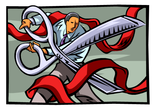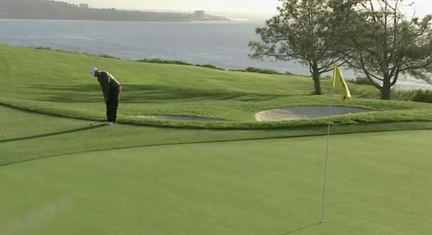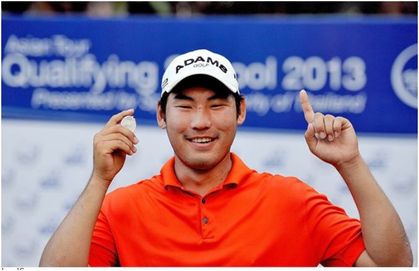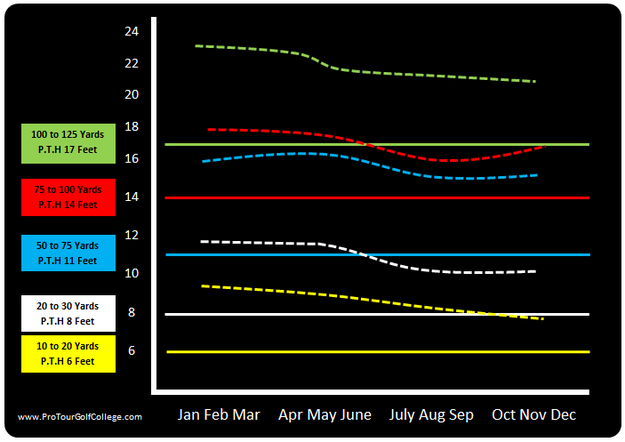 When you play in a golf tournament, to assess how you performed in that event you compare your results to those golfers who finished ahead of you in the field. This is a normal and natural human process that helps you to determine where your game is situated at any particular time. Amateur golfers will customarily compare their golf swings to successful tour professionals; and they will compare their golf scores to other golfers they’re competing against; and they even compare their fashion choice with others in their quest to improve their position or status as a competitive golfer. In last week’s article I discussed the importance of establishing key performance indicators to guide your practice direction and ultimately your performances on the golf course. This week I’ll be talking about how to introduce competitive benchmarking into your development program.  Competitive Benchmarking is a method where you compare your current golf practice processes and golf course performances against the most successful golfers. For example you can compare the way you practice putting results or some other golf skill with professional golfers practicing the same skills, as well as comparing your scores when practicing and performing with them. You can benchmark virtually any skill against the best in the game. So let’s say that you are a good amateur golfer now and you want to be a top level amateur golfer or even a professional golfer in the future, you can look at the performances of the best amateurs and professional performances today and then determine what you need to do to take your game from its current position to that of the very best golfers. Why is this important? Competitive benchmarking challenges elite golfers to examine and also understand where their current golf standard is and gives them a higher standard to continually aim and drive their game at. At Pro Tour Golf College our competitive benchmarks are set against the best golfers on the PGA Tour and European Tour. The reason for this is quite simply that we have access to lots of data that they collect on their players and this helps us to understand just how good these professional tour golfers are. And since they are the best golfers on the planet, it’s not a bad place to start when you think about it.  David showing approach wedge P.T.H of top ranked PGA Tour golfers Many golfers will compare their handicap with another golfer but at Pro Tour Golf College we never compare one golf handicap against another as they’re not a true reflection of an amateur golfers playing standard. We compare golf score averages in tournaments and key golf course statistics such as strokes gained in putting and proximity to the hole metrics. The shot-link data from the US PGA Tour is especially helpful-particularly the data from 100 yards and in as it makes it easier for us to establish accurate and realistic benchmarks for the male and female golfers in our program since virtually every one of them wants to become a successful professional golfer. We believe that all elite golfers can build world class short-games from 100 yards and in and also develop a consistent pro level tee-green performances and the data from the best on the PGA Tour just helps you to stay on track with your performance objectives.  The first place to start is to determine your performance standards for the different shots you are faced with. For instance if you were hitting a chip/pitch or flop shot from within 20 yards of the hole, what would you expect your proximity to the hole to be on average? I bet that you would probably expect your shot to go pretty close to the hole most of the time, but on the PGA Tour the best golfer from 10-20 yards and in (2012) was Justin Rose and from 65 competitive rounds of golf and 138 attempts his proximity to the hole was 5 foot 3 inches or about 1 metre and 60 centimetres. I know that you’re probably thinking that this doesn't seem very close to the hole from just 10-20 yards away from the pin but when you consider all the different situations he was playing his ball from it is an outstanding performance. So this statistic we call ‘Green-Side Skills’ (not including bunker shots). This is a short chip, pitch or flop shot 10 to 20 yards from the hole and even though the distance to the hole is quite short, your ability to get the ball close often really determines to a great extent how many par (or bogey) saves you can make when you miss a green in regulation. So rather than just practicing this green-side shot when close to the hole, (or any shot) it will be more helpful for you establish a performance benchmark first to improve your green-side performances. The table above shows how we do it at Pro Tour Golf College. You can see that we use PGA Tour statistics (10th ranked or tied) to benchmark our players against. In the example above we are benchmarking proximity to the hole metrics from 125 yards and in and also strokes gained metrics for 3 feet to 18 feet in putting (see below). Because we track, test and measure all the distances of shots played on the practice ground and golf course of our students at Pro Tour Golf College we have a very good idea of where they are placed against the best golfers in the game. With a steady stream of results generated we can adjust, and implement specific strategies aimed at moving their performances closer to those of the golfers we benchmark against. This is the great thing about competitive benchmarking in that it allows you to develop highly specific practice plans that can drive on performance improvements in any skill deficient area of your game.
So if you're looking for a great strategy for lowering your golf scores and moving closer to the performances of the top golfers then give competitive benchmarking a try. It might be the best decision you ever make. Lawrie Montague and David Milne - Pro Tour Golf College Your Success on Tour is Our Business How to Choose an Expert Golf Coach Who Will Coach Your Child To Reach Their Full Golf Potential23/2/2013
 One of the juniors who attended our high performance junior camp It may seem like a simple task to choose a golf coach as most golf courses both private and public have golf professionals who give golf lessons and most are PGA or LPGA accredited. But are all golf coaches the same? The simple answer is a big NO! There are many questions you need to ask before you can make a decision on which golf coach you are going to entrust your child's golfing future to. You are not going through the selection process of finding just a golf swing coach (of which there are many) as it is much more involved than that. The golf coach/instructor you choose will need to have many skill sets that can keep developing your son or daughter's skills both on and also off the golf course. There are literally thousands of golf coaches, and especially younger golf coaches out there who would love to dazzle you with hi-tech gadgetry and vocabulary as the only way to teach and develop young golfers. As these hi-tech gadgets and vocabulary do have a place in golf instruction, however they unfortunately can and often do create a "teaching environment" instead of a "learning environment" which is what is required to stimulate the learning and acquisition of golf swing techniques. So if you are serious about developing the full potential of your child especially between the ages of 11 years to 15 years old, then the golf coach/instructor you choose must have a reasonable depth of knowledge and experience to guide them along a relatively seamless Long-Term Player Development Pathway. So below are the requirements that we suggest the coach you select should have in order for him/her to develop young junior golfers into elite golfers. Otherwise at some point they will have to hand your child over to another more experienced and successful elite level golf coach who can fulfill their potential. "There are literally thousands of golf coaches, and especially younger golf coaches out there who would love to dazzle you with hi-tech gadgetry and vocabulary as the only way to teach and develop young golfers."  Michael Sim became the number one ranked amateur in the world
Most method coaches especially the younger inexperienced ones teach a swing that is normally the "flavor of the month" and don't have a complete understanding of the method themselves. The coach must be able to develop the students all round golf game and to do this they must have in place a training regime for the long and short games that is measurable and designed for improvement. There are some fine golf coaches who do an extraordinary job at introducing the game to juniors from ages 5 years old to 10 years old. But like Rudy Duran,Tiger Woods coach from the age of 4 years old, Rudy didn't have the expertise or experience to take a junior golfer like Tiger Woods all the way to world class (Top 100 World Golf Rankings) so he handed him over to someone who could take him all the way to the PGA tour. That job was given to Butch Harmon. The coach you are seeking will have the capacity to blend his experience of coaching golfers with the science of coaching to provide your child with a strong foundation both technically and mentally to help them reach their full potential. So do the research, ask other parents for their feedback and referrals and make an appointment to meet with the different coaches and ask the right questions. And most importantly of all, observe if your child connects with and has a great rapport with the coach. David Milne and Lawrie Montague - Pro Tour Golf College Your Success on Tour is Our Business  Top PGA Tour golfers such as Brandt Snedeker, Phil Mickelson, Tiger Woods and Rory McIlroy must keep identifying ways to stay competitive on tour which is not an easy thing to do when you already have a very low competitive score average. The challenge facing all serious amateur and professional golfers alike is to continually identify ways to improve your golf skills and then find the time to go to work on them. So with this in mind, how do top class amateur and professional golfers keep getting better? Continuous progress in golf requires an active goal setting mind-set followed by a strategic process that guides you towards your improvement goals. Highly specific goals drive your performance upwards and your scores downwards. "Highly specific goals drive your performance upwards and your scores downwards."  Just for illustrative purposes, think of golf performance as a simple linear progression (It isn’t but just imagine it was) and imagine that somewhere along the pathway you decide that something has to change about the way you practice and perform your golf skills to generate improvement. In the illustration you can see that golf performance over time is steady and constant, even after you make a decision to improve. Simple physics tells us that an object in motion (your golf game) will remain on a relatively constant path until it is acted upon by an external force such as the idea to improve one or more of your golf skills. This decision to improve a golf skill once made is the beginning of the process. Then you will need to turn your idea into action to boost your performance upwards. So you will need to apply consistent and deliberate effort (force) for it to change direction.  Key Performance Indicators And the key to boosting golf performances has a lot to do with the performance indicators you establish along the way. Performance indicators (Also called Key Performance Indicators or K.P.I’s) are a type of performance measurement tool that helps you to assess the success of a specific golf practice activity you are employing to boost the direction of your performance in a positive way. Key performance indicators outline a set of standards or values that you use to measure your performance against. These standards are monitored closely and analysed to determine which of your practice strategies is having the most positive influence on generating improved performance. 6 Score Boosting Outcomes At Pro Tour Golf College our K.P.I’s center around what we call the 6 Score Boosting Outcomes that we have discovered has the most positive effect on improving your golf scores. These K.P.I.’s re not in any order because we will use one or all depending on the golfer we’re working with.  HIGHLY SPECIFIC OUTCOMES Boosting golf performance is not a vague or general concept but a highly specific and strategic process that requires careful thought and planning. As you become a better and more effective golfer you need to really become more focused on being specific with your decision making process about how you will take your game to the next level and beyond.  MEASURABLE OUTCOMES There’s an old saying that goes; “what you measure you can manage and improve,” and this is exactly why you have to carefully measure your golf practice and performances on the golf course. If you don’t measure what you’re practicing then how will you know whether it’s working or not?  ACHIEVABLE OUTCOMES When you establish goals or objectives you need to make them achievable with a stretch. What this means is that it takes real skill to manage continuous improvement and there is a fine balance between establishing benchmarks that are achievable with ones that are not. Your outcomes ideally require you to practice in the uncomfortable zone for a time to make steady progress. If it feels comfortable in the beginning then it is likely that you haven’t changed anything.  GOAL DIRECTED OUTCOMES No golfer ever achieved a high level of performance without setting goals that fuel their passion, drive and dedication. Goals give your daily practice effort purpose, and continuous progress requires continuously setting little goals to give you something to always aim at. It is extremely difficult to change an aspect of your golf game without establishing performance goals that help you to stay on the improvement pathway.  PRACTICAL AND RELEVANT OUTCOMES There are many pathways to improvement, and some are simple ideas that you can put into practice easily, and some that are a little more complicated. The key to continuous improvement for us is built around the idea of reducing complexity to increase competency. We know that the more factors involved in the change process the longer it takes and the more complicated it becomes to manage. Identify one or maybe two score boosting factors and start there. Any more than that and it becomes less practical and relevant as it relates to improving skills and reducing your competitive score average.  QUALITY CONTROLLED OUTCOMES At Pro Tour Golf College we are almost fanatical about controlling the quality of the practice experience of our students. Why? Because every golf ball hit with care will accelerate your improvement as long as the information you’re working with is relevant to your needs. Again if we can reduce practice effort down to just the critical factors that have the most influence on improving performance then we have achieved one of our key objectives.  So basically your golf KPI's provide you with the critical to performance data that helps you to understand whether the practice techniques and routines you use are helping or hindering your performances on the golf course. You need to design specific practice routines that improve your performance on the golf course. Then you need to be able to monitor your practice effort to determine whether the work you're putting into your game is actually working or not. We find that that many of the elite golfers we have worked with won't put the extra work into tracking, testing, measuring and monitoring their effort. This makes it almost impossible to determine whether your game is on track or off. There are many statistics programs on the internet that will help you to track your golf course results but unfortunately there is very little for tracking and measuring your golf practice results. Next week I'll show you how to assess your practice to design appropriate practice routines so that the information you gather can help you to improve your golf skills and lower your golf score in competition. Lawrie Montague and David Milne - Pro Tour Golf College Your Success on Tour is Our Business The Korean's have been leading the charge out of Asia over the last fifteen years. With world class women golfers and now male golfers competing and winning on the world stage, including major championships. They are closely followed by the Japanese,Thai's and recently the Chinese. The attention lately has been on the Chinese as they have over the last ten years built literally hundreds of golf courses, trained and certified thousands of teaching professionals and sent their best young amateurs overseas to train and compete against the bes,t and are now seeing the results in amateur golf and on the LPGA Tour.  Arjun Atwal Winning the Wyndam Championship on the PGA Tour But flying under the radar have been the golfers from India who have been going quietly about their business with great success. And I believe the next generation will do even better. India in-fact has a long history in golf as the first club outside of the British Isles was established in Calcutta in 1829 (Royal Calcutta Golf Club). At that point in time the Royal and Ancient Golf Club at St. Andrews was five years away from being established, and it would be 19 years before the gutta percha ball replaced the feathery ball!  India over the last fifteen years has been producing world class golfers in Jeev Milkha Singh, Arjun Atwal, Jyoti Randhawa and recently Shiv Kapur and Gaganjeet Bhullar. Between the six of them they have won on every major tour in the world. It is an impressive record that not many people are aware of and is highlighted below. PGA Tour: 1 win Euro Tour: 7 wins Asian Tour: 27 wins Japan Tour: 5 wins The most successful golfers have been Jeev Milkha Singh and Arjun Atwal. Jeev has won four times each on the European and Japan Tour, plus six on the Asian Tour. Arjun has won on the PGA Tour, three times on the European Tour, and seven times on the Asian Tour. Very Impressive records indeed. Both attended college in the USA (as did Shiv Kapur) as that was the trend in the 1990's where most young Asian golfers with any ability would enroll in the US College system to access good coaching and gain an education at the same time. Over the last five years this paradigm is shifting and for numerous reasons. The young Indian golfer now has more support from the Indian Golf Union who also recognize and support the National Golf Academy of India as the provider of certified golf teachers in India. The NGAI was formed in 2004 and up to date has accredited over 275 teaching professionals and is based in Chandigarh which is where Jeev Milkha Singh was born. There is an organised professional tour (PGTI) which was formed in 2006 and growing each year with 25 tournaments scheduled for 2013. PGTI is now affiliated with the International Federation of PGA tours and has two co-sanctioned events with the Asian Tour (Indian and Sail Open's) and the Avantha Masters with the European Tour. Having a local tour like PGTI allows young professionals to play and compete regularly so they can keep improving and have the opportunity to move up to the Asian Tour and beyond like their role models did. The Indian Golf Union with help from the Royal and Ancient and the PGA of Europe now have the funding, expertise and vision to develop and grow the game of golf in India. Combine this with a working relationship with NGAI and PGTI therefore puts in place a seamless pathway for young golfers to achieve their full potential.  All the above cannot happen if new golfers are not attracted to the game and this is where a company like Evolution Golf (co founded by Shivas Nath and Armit Nigam) plays a big part in filling the base of the pyramid with their Starting New At Golf (SNAG) program. It is designed for the entry- level players and can be set up either indoors or outdoors. This allows the coaching team at Evolution Golf to introduce the game to juniors as young as 3 years old and guide them along a development pathway until they achieve an advanced level. The one area that India lags behind is having enough golf courses and also access to play once the new golfers get the urge to play "real golf". This is where all countries struggle as its easy to get new golfers started but to keep them in the game is the main issue. So if there is any one area that will hold Indian golf back it will be the lack of affordable public access golf courses and practice facilities. It will take all the stakeholders involved with the golf game in India to be on the "same page" and have a long-term player development blueprint in place. They are closer to achieving that goal then they have ever been. With the top three Indian golfers now in their early forties it is time for the next generation to step up and take Indian golf to the top in the World Golf Rankings. And they are! Gaganjeet Bhullar in 2012 has broken into the top 100 of the World Golf Rankings and won multiple times on the Asian Tour. Anirban Lahiri at the age of 25 has also won twice on the Asian Tour and moving up the rankings. Both India and China will follow Korea's footsteps and start to impact men's and women's world golf in the next decade. Golfers from the USA dominated golf in the 50's,60's,70's and will always be the benchmark for golfers around the world to beat. But in the 80's, 90's and 21st century European (including South African's) have challenged the US dominance from majors to team events. The same will happen in the next twenty years when more and more golfers from Asia rise and become World Class. I believe Indian golfers will be represented and be leading that charge. Indian golf has a proud and long history and with the role models like Jeev, Arjun and Jyoti leading the way the younger Indian golfers have a great opportunity to make more history in the 21st Century. David Milne and Lawrie Montague - Pro Tour Golf College Your Success on Tour is Our Business How to Practice Golf: The Amount of Hours of Practice You Need to Become a Successful Tour Golfer8/2/2013
There are 365 days in a year and out of all those days you have to spend a high percentage of them practicing and competing at your golf to have any chance of becoming a successful professional golfer. How many hours of effort? This is the big question and in today's article I'll share with you the magic number. Because we train amateur golfers to become tour golfers we get asked many times how much practice you have to do every day to become a professional golfer. In other words how hard do you really have to work at golf each and every day? In our opinion and based on our extensive experience and empirical evidence you need to invest a minimum of 1,728 hours per year to give yourself the best chance possible of becoming a successful professional golfer. This works out at least 6 hours of practice per day for 6 days per week for 48 weeks per year. As you spend around 4.5 to 6 hours on a golf course when you play you need to spend at least the same amount of time on the practice fairway. And you will need to do this for at least 7 to 10 years if you want to make a good living from playing professional golf. Of course this does not take into account the many variables that influence your level of success such as the quality of practice effort each day, the amount of tournaments you compete in per year and also the quality of the coaching/instruction you receive. Can you do it in less time? Yes it is possible, however we find that the hours expressed above are the minimum amount of time required.  If you can currently score close to par or better when you compete in tournaments and you want to become a successful professional golfer you need to know the amount of time and effort you have to commit to the improvement of your game if you want to give yourself a chance of making it. We have noticed a definite performance shift in competitive golf where the layer of successful golfers is increasing because golf is attracting more serious golfers from more and more countries who are investing the time, effort and financial resources to get onto a professional golf tour. What this means is that your decision to become a professional golfer in the 21st century is a huge commitment of time, effort and money. It’s conceivable that you will invest many thousands of dollars to get to the standard that allows you to qualify and play on a professional golf tour. Do you practice and compete at least 6 days per week. If you don’t but you want to become a professional golfer then you need to start thinking about how you will invest your time each day in an effort to lower your competitive scoring average. By the time you get to tour school you will have to be able to consistently shoot scores under par 60 percent or more of the time and your high score average will not be higher than 2 or 3 over par. Now this is great news for many of the golfers who read our articles because if you are already doing this then great, and if you are not, then you can quickly change this situation.  So your time and effort commitment is 6 hours per day multiplied by 6 days per week multiplied by a 48 weeks per year multiplied by a minimum of 10 years. Here’s the magic number… 17,280 hours. Do not be deceived into thinking that to become a successful professional golfer is easy, or takes less time, it-does-not! Tour professionals are the product of thousands of hours of effort to hone their skills to the level that allows them to compete successfully. Plan your practice each day so that you spend your time up-skilling your critical to performance skills so that you get yourself on the pathway to lower golf scores. Every stroke of improvement will equal a minimum of one thousand hours of deliberate practice effort to continually improve. One thousand hours is about 30 weeks of practice. Start today, and expect your journey to be long and hard. The only advantages are practicing with a well-designed plan and a commitment to focusing on your goals despite the many distractions that will try to tempt you away from your daily commitment. But stay the course and never look back. In the hours, weeks, months and years ahead you will move ever closer to your dream of competing successfully on a professional golf tour. Lawrie Montague and David Milne - Pro Tour Golf College Your Success On Tour is Our Business  Watch the PGA Tour or European Tour any week and you quickly notice that the guys playing the best that week are the ones making lots of birdies. Most weeks the four round winning total will be 15 under or better, and to finish in the top 20 you will have to shoot under par nearly every day. Tiger Woods is a case in point recently winning the Farmers Insurance open at Torrey Pines. Of all the statistics that make up his performances over four days the one that continually stands out to me is his ability to play the par 5’s as par fours. Over four rounds played on the South Course and the North Course at Torrey Pines Tiger had 9 birdies, 2 eagles, 4 pars and 1 bogey out of the 16 par 5’s he played. Now that’s a pretty impressive effort. Now you might think that he hits lots of par fives in two shots and two putts for his birdies (or eagles) but this is simply not the case. In-fact what Tiger Woods does better than most professional tour golfers week in and week out is hit his approach wedge shots with a high degree of control both in terms of accuracy and more importantly distance. Quite simply, he gives himself many chances to make birdies on par 5 holes because of his exceptional ability to hit his approach wedge shots close to the hole. A number of times in the tournament he layed his approach shot up to very specific distances from the pin on par 5 holes and then proceeded to hit his wedge shots to within 6 feet of the hole. Quite often he was hitting his wedge shot from around 100 to 110 yards from the pin and would hit his shot time and time again next to the flag. So how does he do it? How does Tiger control his distances so well with a wedge in his hand? Well, I can’t tell you specifically how Tiger actually practices his wedge shots because he’s pretty guarded about sharing the way he goes about practicing and improving his skills, but through his actions on the golf course he lets us in on some of his secrets. Firstly he values his short-game ability very highly and when asked during the tournament how his game was he explained that his short-game was where he wanted it to be which might suggest that he had a goal to get it to a certain standard leading into the event at Torrey Pines. There is so much discussion about what he’s doing with his full-swing technique but the truth is that he is a lot better with his approach wedge shots and greenside skills than he is with a driver or long iron in his hand.  Tiger's putting average is also low the weeks he’s in contention in a tournament because he hits his approach shots and greenside shots to within a range of the hole where the probability of making the putt is higher. From 5 feet to fifteen feet during the tournament he made 50 percent of the putts he faced and if you think about it; many of the shots he hit within this range were played from inside 120 yards of the hole. The challenge that most golfers face is managing the limited amount of time they have in a week to work on the many different aspects of their game to become a more competitive golfer. And if you’re serious about lowering your golf scores then greatly improving your wedge approach shots will make a big difference to your scores. Having a limited amount of time to practice might seem like a good reason not to work as hard on your game as you need to but with the simple practice routine I’ll share with you in this article you’ll be able to extract a lot more from your wedge game on the practice ground.  Pro Tour Golf College Student Measuring Distance to Flag Feel to Finesse Drill The key to becoming a great wedge player is to develop specific feels for distances within 100 yards of the hole. At Pro Tour Golf College we teach our students a routine we call “The Feel to Finesse Drill” which is a practice routine that shows them how to develop their feel for various distances within 100 yards of the flag. This practice routine develops their wedge capability so they can compete with confidence because they can control their wedge distances more effectively. To start with you’ll need a couple of people to help you (your golf coach and one other) to perform this training routine properly, and an area of ground that would allow you to hit golf shots out to 100 yards. In this routine you will hit 5 sets of 10 golf shots (50 shots) with the objective of hitting them specific distances (with no targets to hit to, just open ground) that are randomly generated by your assistant. This means that before you walk in to hit each approach wedge shot your assistant will call out a distance between say 30 yards and 100 yards (47 yards, 33 yards, 65 yards…) and your job is to hit the shot that distance. Each time you hit the shot someone waiting on the side of the practice area will walk across to spot where your golf ball hit the ground and standing on that spot they will measure the distance back to you with a laser and then call out the distance you hit it. You will write the original distance down (See table below) and the actual distance you hit the shot (47/49 = + 2) to gauge your ability to hit random distance shots the correct distance by relying purely on the feel in your swing for the distance. Hit 50 golf shots and then evaluate your performance by measuring how many of your shots landed at the correct distance. Then measure how many of your approach shots were within 3 feet, 6 feet, 9 feet etc. of the specific distance. The objective of this practice routine is to hit your golf shots as close as you can to the random distance called out. Remember there should be not target to hit to as you're relying just on your 'feel for distance' to achieve your goal.
Practice The Feel to Finesse Drill often and you will quickly discover that this is one of the very best practice routines to teach you how to hit accurate wedge shots close to the hole just like Tiger Woods, giving you your best chance of converting the putt and lowering your golf score average. You don't need a lot of time to practice golf skills correctly. But you do need to design your practice to achieve highly specific outcomes if you want to develop into a competitive amateur or professional golfer. Lawrie Montague and David Milne - Pro Tour Golf College Your Success On Tour is Our Business  The 2013 Asian Tour school is now completed and forty one players were successful in gaining their tour cards. A record number of players entered (761) from thirty different countries. Japan (129) and Korea (121) had the largest representation followed by Australia (77), USA (67), Thailand (56) and Chinese Taipei (52). Australia had the most players (8) to earn a tour card followed by Japan (5) USA and Thailand with (4). Out of the total of forty one successful participants sixteen were from Asia and within that number six are from South East Asia. As my business partner at Pro Tour Golf College Lawrie Montague and I have said many times; tour school is a tough business and you have to prepare properly for it. 761 entered 2013 Asian Tour School and only 41 got their cards. Thats just 5.38 percent that succeeded! The winner of the final stage was Korean born American Chan Kim with a 13 under score of 272. He now has the opportunity to follow in the footsteps of many graduates in previous years who have gone on to bigger things. The names that come straight to mind are Thonchai Jaidee and Charlie Wi. Thongchai is on the verge of breaking into the top 50 World Golf Ranking which will get him into all the majors for 2013 and Charlie is now an established player on the US PGA Tour, and is not far away from winning out there. So the question is what is stopping more players from S.E. Asia from getting their Asian Tour Card? Apart from host country Thailand, only Nicolas Fung (Malaysia) and Choo Tze Huang (Singapore) earned full cards for the first time from S.E.Asia. Both these players have been playing the OneAsia Tour the last couple of years and both had very good records as amateurs before turning professional. Add these two players to the likes of Rory Hie (Indonesia), Miguel Tabuena (Philippines) and Siva Chandra (Malaysia) and you quickly realise that ability is not the issue. All these players were literally world class junior golfers and in particular Rory Hei was the number two ranked junior on the US Junior Golf Tour infront of juniors like Rickie Fowler.  Rory, Miguel (Pictured) and Siva all missed their card by one solitary shot! Heart breaking in anyones language. So is it the pressure of competing at tour school? Yes it has a big bearing, but all these players qualify for country exemptions which will get them automatic entry into most tournaments on the Asian Tour apart from the co-sanctioned tournaments. Also most will get entry into the final stage of tour school and by pass the competitive 1st stage where over 600 players from the total entry of 761 have to negotiate. The two reasons above mentioned should allow them to play with an attitude of nothing to lose compared to the others. But if you look at the background of the majority of those who gained their Asian Tour Card you will see that they have been professionals for at least five years and have played at a high level for most of that time. Running through the names you come accross David Lutterus (Aust) who played on the US PGA Tour for two years (2008 & 2010) and Web.Com for another threee years. Miles Tunnicliff has been a regular on the European Tour for over ten years and has also won on that tour. Anton Haig from South Africa also played and won on the European Tour (Asian Johnny Walker). Therefore experience is a major factor in helping players negotiate and handle the pressure at tour school but are there other factors holding back and in-fact limiting young S.E. Asian professionals from realising their full potential? Yes there is, and it generally takes ten years for these professionals to figure it out and become successful on tour. A good case is Mardan Mamat a winner on the Asian and European Tours. In 1994 he was the best amateur in S.E. Asia after winning numerous tournaments in the region at the age of twenty four. In took him though until the age of thirty five to establish himself on tour and become a winner. He and many like him from Malaysia, Philippines, Singapore and Indonesia work extrmely hard on their games but not on the right things that will help them achieve better results in less time.  The main focus is on improving golf swing technique mainly and the lack of high calibre wedge and greenside practice facilities does not help them to develop the scoring part of their game to the tour level standard. With time and experience they do improve, but it takes them much longer to get to where they want to go. Other factors include not having an annual periodization program in place that allows them to peak their golf games for important events during the year, and tour school would be high on the list. A well designed periodization program will also help them to monitor and deal with physical and mental fatigue that significantly influences day to day performance. Next on the list would be a "Tour Player Long Term Development Program" with benchmarks set in place for practice, competition and statistical monitoring and assessment throughout the year. No one is doubting the ability or work ethic of the players from the South East Asian region but when they are competing against players from other parts of the world who have access to the best coaching practices, sports medicine support, biomechanical testing, and training programs designed for generating improvement, it makes it tough to compete against this standard. Combine the above with financial management and travel planning know how, which are the basic tools required to make it on any major professional golf tour.  From this region Thailand is showing the way in professional golf with Thongchai Jaidee (European tour Winner) and Thawon Wirachant winner of the 2012 Asian Tour Order of Merit and recieving an invite to the US Masters in April. The younger professional in Thailand now have great role models to inspire them to become world class professionals (Top 100 in world golf ranking). Thailand also has a strong local tour to nuture and develop the professionals with the help of great sponsors like Singha and their subsidiary Sports Management Group. Malaysia is folowing in Thailand's footsteps of developing a local tour. Professional Golf of Malaysia has put together a tournament schedule of 22 tournaments and a qualifying school every month. Total prize money is RM $4,103,250.00 (US$1,320,647.00) and will go a long way to giving the local professional the opportunity to develop their professional playing skills. Will the other countries like Singapore, Philippines and Indonesia follow the lead of Thailand and Malaysia and develop their own Long-Term Player Development Programs? Certainly interesting times ahead for South East Asia golf. David Milne and Lawrie Montague - Pro Tour Golf College Your Success On Tour is Our Business |
Archives
June 2019
|
Proudly Supported By
Copyright © 2011 - 2018 Pro Tour Golf College
Website Managed By Golf Performance Media
All Rights Reserved
Website Managed By Golf Performance Media
All Rights Reserved








 RSS Feed
RSS Feed



